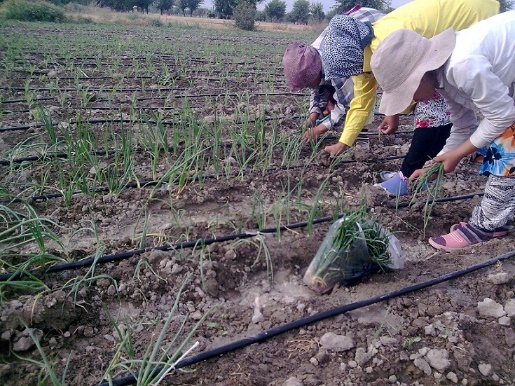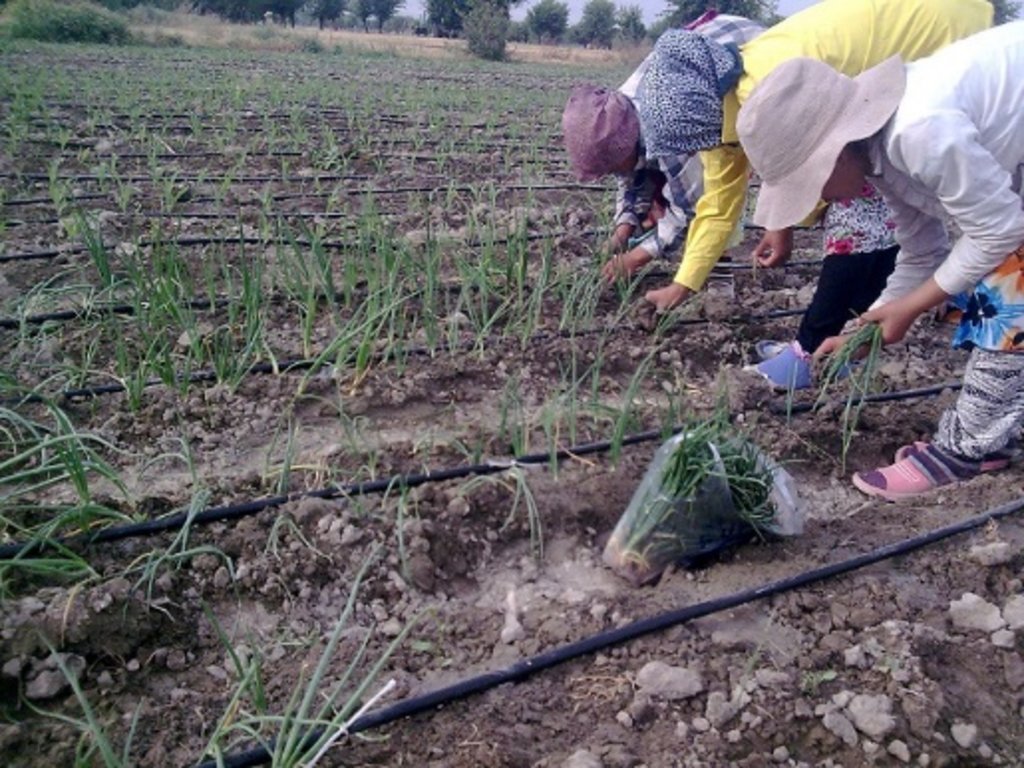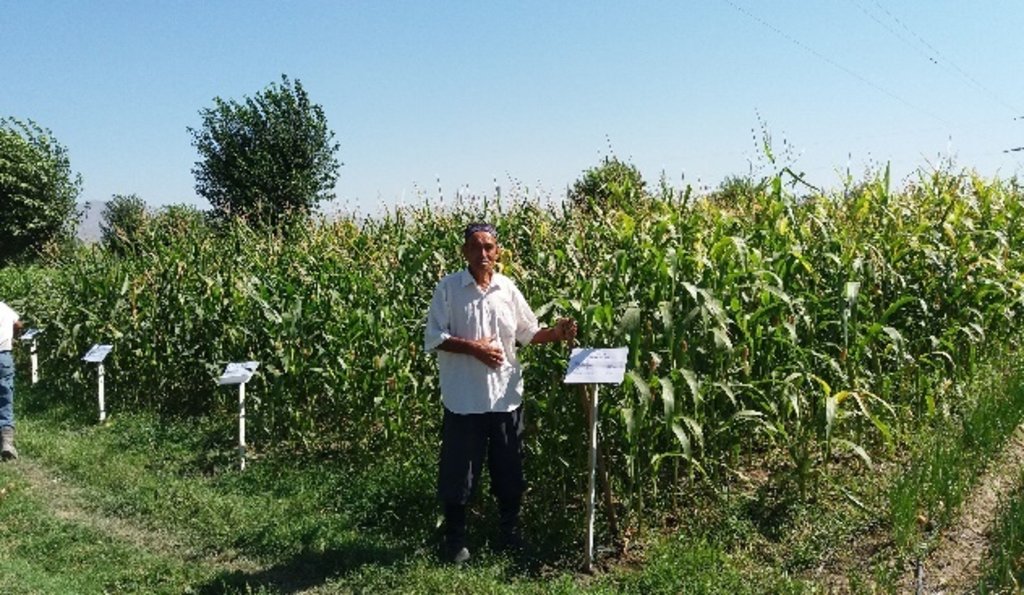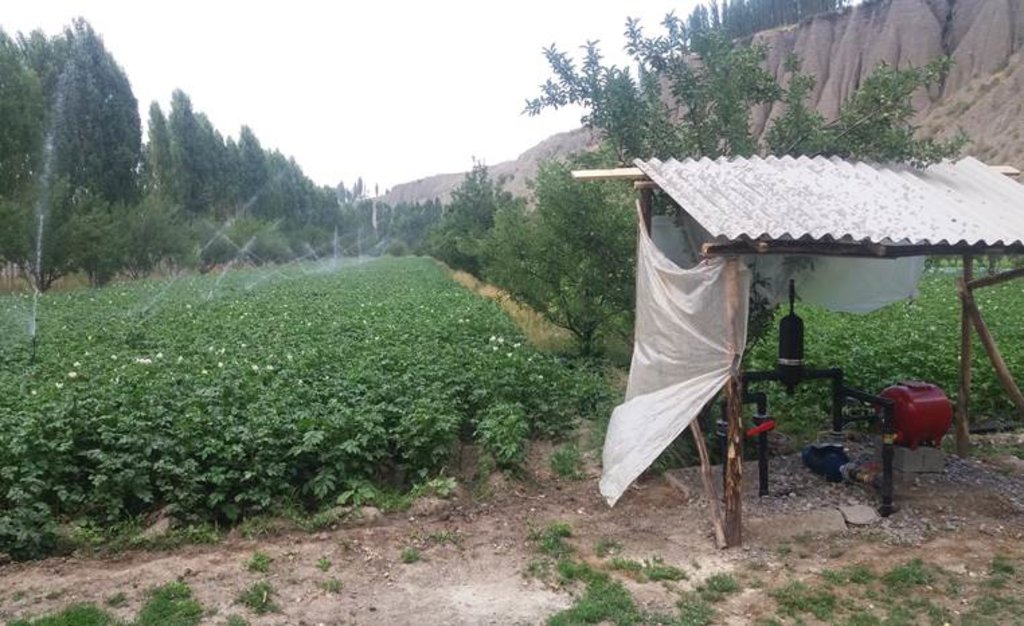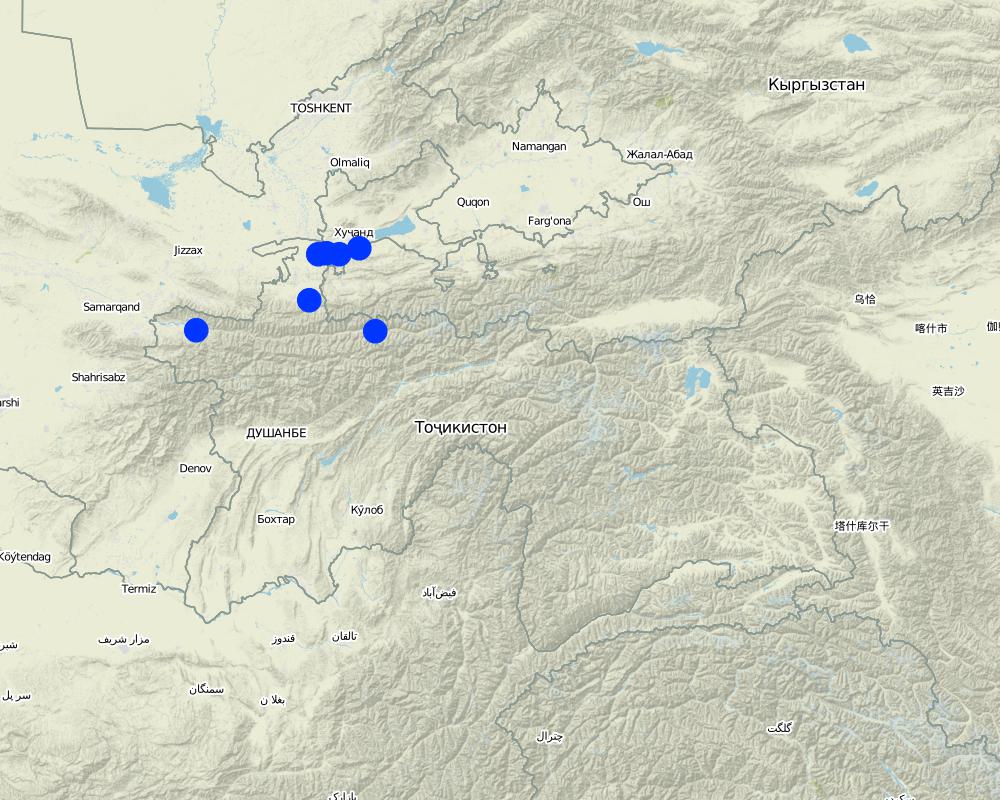Integrated farming on irrigated lands for adaptation to changing climate [Tadjikistan]
- Création :
- Mise à jour :
- Compilateur : Stefan Michel
- Rédacteur : –
- Examinateur : Umed Vahobov
Интегрированное ведение земледелия на орошаемых землях для адаптации к изменению климата
approaches_4316 - Tadjikistan
Voir les sections
Développer tout Réduire tout1. Informations générales
1.2 Coordonnées des personnes-ressources et des institutions impliquées dans l'évaluation et la documentation de l'Approche
Personne(s) ressource(s) clé(s)
Spécialiste GDT:
Negmatov Negmatjon
negmatdzhon.negmatov@giz.de
Deutsche Gesellschaft für Internationale Zusammenarbeit (GIZ)
Tadjikistan
Nom du projet qui a facilité la documentation/ l'évaluation de l'Approche (si pertinent)
Strengthening of Livelihoods through Climate Change Adaptation in Kyrgyzstan and TajikistanNom du ou des institutions qui ont facilité la documentation/ l'évaluation de l'Approche (si pertinent)
GIZ Tajikistan (GIZ Tajikistan) - Tadjikistan1.3 Conditions relatives à l'utilisation par WOCAT des données documentées
Quand les données ont-elles été compilées (sur le terrain)?
29/11/2018
Le compilateur et la(les) personne(s) ressource(s) acceptent les conditions relatives à l'utilisation par WOCAT des données documentées:
Oui
1.4 Références au(x) questionnaire(s) sur les Technologies de GDT

Applying drip irrigation for efficient irrigation water use … [Tadjikistan]
Drip irrigation substantially saves water compared to conventional furrow irrigation. Here the technology is applied for different perennial and annual crops and with use of different sources of water.
- Compilateur : Stefan Michel
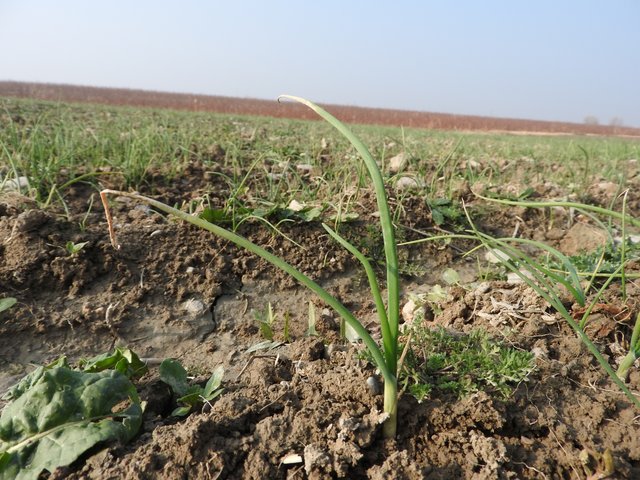
Onion production by greenhouse propagation and transplantation [Tadjikistan]
Onion seeds are sown in sheeting greenhouses, where the onion seedlings are propagated. The seedlings are then replanted in the open field. This makes them less prone to extreme weather events and provides higher yield of better quality.
- Compilateur : Stefan Michel
2. Description de l'Approche de GDT
2.1 Courte description de l'Approche
Irrigated agriculture faces challenges from climate change impact and growing competition for irrigation water. The approach to get "more crop per drop" reduces the adverse effect of these impacts and improves the income of farmers.
2.2 Description détaillée de l'Approche
Description détaillée de l'Approche:
Irrigated cultivation of onion, potatoes, corn and other crops is hampered by poor agricultural practice and these challenges are increasingly exacerbated by the impact of climate change. The already visible trends and predictions show higher levels of aridity, higher temperatures during the vegetation season, reduced overall precipitation in catchment areas, more irregular rainfall patterns, reduced snow packs and accelerated snow melt as well as the loss of glaciers as buffers of water flow. These factors all cause a reduction of available irrigation water, while higher temperatures and expansion of irrigated agriculture – partly also caused by increasing aridity and reduced feasibility of rain-fed farming – lead to higher irrigation water demand. At the same time irrigated agriculture has low irrigation water use efficiency in terms of yield, crop quality and created income.
Other problems in irrigated cultivation of onion, potatoes, corn and other crops are caused by poor agricultural practice. Crop varieties producing high yield of good quality under the local conditions are not available for local farmers. Insufficient knowledge about the use of agrochemicals, difficult access to these and financial shortages experienced by farmers during the time of planting and growing of crops cause the inadequate application of fertilizer and pesticides and cause crop losses and quality issues. Only wealthy farmers are able to purchase timely sufficient amounts of agricultural inputs. Most farmers apply insufficient amounts and inadequate combinations of fertilizers, thus causing a declining soil fertility, which affects quantity and quality of harvested crops. Unreliable harvest amounts and inconsistent quality reduce the marketability of the agricultural products and cause low income levels of farmers, again affecting their ability to work their lands effectively and sustainable. Additionally, a policy of “one village – one product” has contributed to higher risks in cases of crop failure or production exceeding demand.
The approach aims at reducing these risks and obstacles in an integrated way under consideration of ongoing trends and predicted impacts of climate change. The approach therefore combines several elements through an agricultural extension service:
•Agricultural extension service providing tailored assistance to the farmers;
•Provision of agricultural inputs through the extension services to ease the application of technical advice and reduce transaction costs for the farmers;
•Packages of agricultural inputs include seeds/planting material, fertilizers and pesticides as well as growth regulator with the instruction for their correct use;
•The agricultural extension service provides access to crop varieties, which are adapted to the local site conditions and produce reliable high yields of best quality;
•Agricultural inputs are provided to farmers on a part loan basis by the extension service: farmers pay 50% of the costs of the package when purchasing, the remaining 50% are paid after harvest, with a zero interest rate (the extension service buys the inputs at bulk price and sells them to the farmers at retail price, which is 115% of the bulk price);
•Technological assistance includes the use of seeding machines and cultivation technology like the transplanting of pre-grown seedlings of onion or rice;
•Farmers are advised to diversify their crops in accordance to the local site conditions and market demand.
Additionally the project has assisted with testing and demonstration of different irrigation technologies, e.g. drip irrigation in various crops and sprinkler irrigation in potato cultivation. The result of these trials are used by the agricultural extension service to advise farmers under what site conditions, costs of irrigation water and other inputs, expected yields and predicted market demand the application of such costly irrigation techniques can be economically reasonable.
2.3 Photos de l'approche
2.5 Pays/ région/ lieux où l'Approche a été appliquée
Pays:
Tadjikistan
Région/ Etat/ Province:
Sughd region
Autres spécifications du lieu :
B. Gafurov, J. Rasulov, Spitamen, Devashtich and Panjakent districts
Map
×2.6 Dates de début et de fin de l'Approche
Si l'année précise est inconnue, indiquez approximativement quand l'Approche a démarré:
il y a moins de 10 ans (récemment)
2.7 Type d'Approche
- fondé sur un projet/ programme
2.8 Principaux objectifs de l'Approche
Improved agricultural productivity in terms of yields and quality under conditions of climate change.
2.9 Conditions favorisant ou entravant la mise en œuvre de la(des) Technologie(s) appliquée(s) sous l'Approche
disponibilité/ accès aux ressources et services financiers
- entrave
Farmers have difficulties to afford agricultural inputs at the beginning of the growth season. This issue is addressed in the approach through part loans.
cadre institutionnel
- favorise
Agricultural extension service collaborates with GIZ and was ready to jointly develop and adopt the approach.
3. Participation et rôles des parties prenantes impliquées dans l'Approche
3.1 Parties prenantes impliquées dans l'Approche et rôles
- exploitants locaux des terres / communautés locales
Farmers
Applying the approach on their lands.
- Spécialistes de la GDT/ conseillers agricoles
Agricultural experts
Providing technical advice.
- ONG
NGO Neksigol
Agricultural extension service - advisory role.
- secteur privé
Neksigol Group of Companies
Provider of agricultural inputs.
- gouvernement local
Agricultural department of Devashtich district, Agricultural departments of other districts
Interested in improvement of agricultural production and resulting well-being of the local population and economic prosperity of their districts. Political backing and support, provision of information, facilitation of contacts.
- organisation internationale
Deutsche Gesellschaft für Internationale Zusammenarbeit (GIZ)
Implementation of the project on behalf of the German government.
Si plusieurs parties prenantes sont impliquées, indiquez l'organisme chef de file ou l'institution responsable:
Deutsche Gesellschaft für Internationale Zusammenarbeit (GIZ)
3.2 Participation des exploitants locaux des terres/ communautés locales aux différentes phases de l'Approche
| Participation des exploitants locaux des terres/ communautés locales | Spécifiez qui était impliqué et décrivez les activités | |
|---|---|---|
| initiation/ motivation | interactive | Discussion of testing of elements of the approach on their lands |
| planification | interactive | Discussion of testing of elements of the approach on their lands |
| mise en œuvre | interactive | Applying elements of the appraoch on their lands |
| suivi/ évaluation | interactive | Recording of yield and crop quality, reporting experiences in applying the elements of the approach. |
3.4 Prises de décision pour la sélection de la Technologie/ des Technologies
Indiquez qui a décidé de la sélection de la Technologie/ des Technologies à mettre en œuvre:
- principalement les spécialistes de la GDT, après consultation des exploitants des terres
Spécifiez sur quelle base ont été prises les décisions:
- l'évaluation de connaissances bien documentées en matière de GDT (prises de décision fondées sur des preuves tangibles)?
- les résultats de recherches?
- expériences et opinions personnelles (non documentées)
4. Soutien technique, renforcement des capacités et gestion des connaissances
4.1 Renforcement des capacités/ formation
Une formation a-t-elle été dispensée aux exploitants des terres/ autres parties prenantes?
Oui
Spécifiez qui a été formé:
- exploitants des terres
Formats de la formation:
- zones de démonstration
- cours
4.2 Service de conseils
Les exploitants des terres ont-ils accès à un service de conseils?
Oui
Spécifiez si le service de conseils est fourni:
- dans les champs des exploitants?
- dans des centres permanents
4.3 Renforcement des institutions (développement organisationnel)
Des institutions ont elles été mises en place ou renforcées par le biais de l'Approche?
- oui, un peu
Spécifiez à quel(s) niveau(x), ces institutions ont été renforcées ou mises en place:
- local
Décrivez l'institution, ses rôles et responsabilités, ses membres, etc.
Agricultural extension service and provider of agricultural inputs expanded their fields of work and their reach of farmers.
Précisez le type de soutien:
- financier
- renforcement des capacités/ formation
4.4 Suivi et évaluation
Le suivi et l'évaluation font ils partie de l'Approche? :
Oui
Commentaires:
Documentation of yields and quality of harvest, recording of inputs.
Si oui, ce document est-il destiné à être utilisé pour le suivi et l'évaluation?
Non
4.5 Recherche
La recherche a-t-elle fait partie intégrante de l’Approche?
Non
5. Financement et soutien matériel externe
5.1 Budget annuel de la composante GDT de l'Approche
Si le budget annuel précis n'est pas connu, indiquez une fourchette:
- 10 000-100 000
Commentez (par ex. principales sources de financement/ principaux bailleurs de fonds):
Government of Germany, implemented via Deutsche Gesellschaft für Internationale Zusammenarbeit (GIZ). The approach has been implemented in the frame of a much larger program and the specific budget for the SLM component of the Approach cannot be determined.
5.2 Soutiens financiers/ matériels fournis aux exploitants des terres
Les exploitants des terres ont-ils reçu un soutien financier/ matériel pour la mise en œuvre de la Technologie/ des Technologies?
Oui
Si oui, spécifiez le(s) type(s) de soutien, les conditions et les fournisseurs:
Loan of 50% of the retail price of agricultural input packages, to be recovered after harvest at zero interest rate.
5.3 Subventions pour des intrants spécifiques (incluant la main d'œuvre)
- intrants agricoles
| Spécifiez les intrants subventionnés | Dans quelle mesure | Spécifiez les subventions |
|---|---|---|
| semences | en partie financé | Loan of 50% of the retail price of agricultural input packages, to be recovered after harvest at zero interest rate. |
| fertilisants | en partie financé | Loan of 50% of the retail price of agricultural input packages, to be recovered after harvest at zero interest rate. |
Si la main d'œuvre fournie par les exploitants des terres était un intrant substantiel, elle était:
- volontaire
Commentaires:
Work on their own fields for their own income generation.
5.4 Crédits
Des crédits ont-ils été alloués à travers l'Approche pour les activités de GDT?
Oui
Spécifiez les conditions (taux d'intérêts, remboursements, etc.):
Loan of 50% of the retail price of agricultural input packages, to be recovered after harvest at zero interest rate. (The extension service buys the inputs at bulk price and sells them to the farmers at retail price, which is 115% of the bulk price.)
Spécifiez les fournisseurs du crédit:
Agricultural extension service / provider of agricultural inputs.
Spécifiez les destinataires du crédit:
Farmers
5.5 Autres incitations ou instruments
D'autres incitations ou instruments ont-ils été utilisés pour promouvoir la mise en œuvre des Technologies de GDT?
Oui
Si oui, spécifiez:
The combination of advisory service, provision of a complete package of inputs and financial support (loan).
6. Analyses d'impact et conclusions
6.1 Impacts de l'Approche
Est-ce que l'Approche a autonomisé les exploitants locaux des terres, amélioré la participation des parties prenantes?
- Non
- Oui, un peu
- Oui, modérément
- Oui, beaucoup
Participating farmers increased their confidence and status.
Est-ce que l'Approche a permis la prise de décisions fondées sur des données probantes?
- Non
- Oui, un peu
- Oui, modérément
- Oui, beaucoup
The direct link between the quality of agricultural input and practices and resulting yield and crop quality became visible.
Est-ce que l'Approche a aidé les exploitants des terres à mettre en œuvre et entretenir les Technologies de GDT?
- Non
- Oui, un peu
- Oui, modérément
- Oui, beaucoup
The farmers were enabled to apply technical advice from the extension service as agricultural inputs were made easier available and affordable.
Est-ce que l'Approche a mobilisé/ amélioré l'accès aux ressources financières pour la mise en œuvre de la GDT?
- Non
- Oui, un peu
- Oui, modérément
- Oui, beaucoup
Farmers were enabled through a part loan to purchase input packages.
Est-ce que l'Approche a amélioré les connaissances et les capacités des exploitants des terres pour mettre en œuvre la GDT?
- Non
- Oui, un peu
- Oui, modérément
- Oui, beaucoup
Provision of targeted extension.
Est-ce que l'Approche a amélioré les connaissances et les capacités des autres parties prenantes?
- Non
- Oui, un peu
- Oui, modérément
- Oui, beaucoup
Involved extension service and agricultural departments gained knowledge.
Est-ce que l'Approche a construit/ renforcé les institutions, la collaboration entre parties prenantes?
- Non
- Oui, un peu
- Oui, modérément
- Oui, beaucoup
Existing collaboration between farmers, extension services and agricultural departments consolidated.
Est-ce que l'Approche a conduit à améliorer la sécurité alimentaire et/ou la nutrition?
- Non
- Oui, un peu
- Oui, modérément
- Oui, beaucoup
Increase in yields and crop quality.
Est-ce que l'Approche a amélioré l'accès aux marchés?
- Non
- Oui, un peu
- Oui, modérément
- Oui, beaucoup
More reliable quantities and quality of crop allow improved market access.
Est-ce que l'Approche a conduit à des emplois, des opportunités de revenus?
- Non
- Oui, un peu
- Oui, modérément
- Oui, beaucoup
Higher yields and better marketability increase incomes of farmers. Demand for inputs improves business and employment opportunities of provider of inputs.
6.2 Principale motivation des exploitants des terres pour mettre en œuvre la GDT
- augmenter la production
- augmenter la rentabilité/ bénéfice, rapport coûts-bénéfices
6.3 Durabilité des activités de l'Approche
Les exploitants des terres peuvent-ils poursuivre ce qui a été mis en œuvre par le biais de l'Approche (sans soutien extérieur)?
- incertain
Si non ou incertain, spécifiez et commentez:
Many farmers will not be able to purchase the package of advise and inputs without loan support. Such loans are currently not available from commercial financial institutions at affordable conditions.
6.4 Points forts/ avantages de l'Approche
| Points forts/ avantages/ possibilités du point de vue de l'exploitant des terres |
|---|
| Improved crop production. |
| Points forts/ avantages/ possibilités du point de vue du compilateur ou d'une autre personne ressource clé |
|---|
| Improved crop production. |
| Increased crop per amount of irrigation water. |
| Preservation of soil fertility. |
6.5 Faiblesses/ inconvénients de l'Approche et moyens de les surmonter
| Faiblesses/ inconvénients/ risques du point de vue de l’exploitant des terres | Comment peuvent-ils être surmontés? |
|---|---|
| High costs of inputs can by most farmers only be met with loan, at better conditions than typical commercial loans. | Loans at affordable conditions. |
| Faiblesses/ inconvénients/ risques du point de vue du compilateur ou d'une autre personne ressource clé | Comment peuvent-ils être surmontés? |
|---|---|
| High costs of inputs can by most farmers only be met with loan, at better conditions than typical commercial loans. | Loans at affordable conditions. |
7. Références et liens
7.1 Méthodes/ sources d'information
- visites de terrain, enquêtes sur le terrain
- interviews/entretiens avec les exploitants des terres
- interviews/ entretiens avec les spécialistes/ experts de GDT
Liens et modules
Développer tout Réduire toutLiens

Applying drip irrigation for efficient irrigation water use … [Tadjikistan]
Drip irrigation substantially saves water compared to conventional furrow irrigation. Here the technology is applied for different perennial and annual crops and with use of different sources of water.
- Compilateur : Stefan Michel

Onion production by greenhouse propagation and transplantation [Tadjikistan]
Onion seeds are sown in sheeting greenhouses, where the onion seedlings are propagated. The seedlings are then replanted in the open field. This makes them less prone to extreme weather events and provides higher yield of better quality.
- Compilateur : Stefan Michel
Modules
Aucun module trouvé


